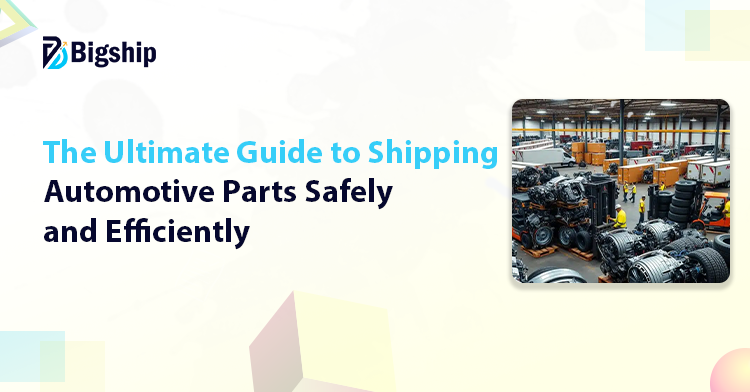Shipping automotive parts is not as straightforward as packing a box and calling a courier. Car parts come in all shapes and sizes, are heavy and greasy, like transmissions; some are light and bulky, like bumpers or hoods. Whether you are a business owner or an individual who sells car parts on eBay or Facebook Marketplace, knowing how to ship car parts safely and affordably is key. Choosing the wrong method, packing inappropriately, or working with an unreliable car parts shipping company can turn what ought to have been a smooth delivery into a nightmare at least one would want to forget.

In this guide, you’ll learn just about everything concerning shipping auto parts-from pickings and packing tips to carrier options and insurance considerations.
Step-by-step guide to auto parts shipping
Shipping will vary depending on car parts, so all have their methods. The right methods mean fewer delays, cheaper prices, and less damage. Follow these six basics to ensure your auto parts shipping goes correctly.
1. Assess Your Packaging Needs
Auto parts can be heavy, big, or oddly shaped, so regular boxes may not work. Plan how to pack each part. Use wrapping, padding, and sealing to protect them. Don’t forget to add shipping labels with the correct delivery and return addresses.
2. Measure and weigh the items properly
Shipping companies charge based on size and weight. If your details are wrong, they might add extra fees or delay your shipment.
3. Choosing the perfect shipping method
Pick a shipping option based on how fast you want the item to reach and how much you’re willing to spend. Express shipping is quick but costs more. Standard shipping takes longer but is cheaper. Shipment’s size, weight, and urgency will inform what shipping method is most suitable:
Parcel: For smaller parts (weighing in at less than 150 lbs.) that fit in boxes.
Less Than Truckload (LTL): Larger or heavier parts that are unwilling to fill a truck.
Full Truckload (FTL): Large shipments that require the entire truck or shipments that are time sensitive.
4. Select a reliable carrier
Choose a courier partner that can be trusted, one with experience in the shipping of car parts. Check on LTL rating from previous clients in this online tool, just to make sure about their reliability.
5. Protect your investment
Based on the value of the auto parts being transported, consider taking shipping insurance to cover against loss or damage. This gives financial protection against unexpected incidents such as accidents, natural disasters, or theft while in transit. Carefully read the insurance policy to determine the coverage amount, exclusions, and claims process.
6. Track your shipment
Track your auto parts once they’re on the move, and keep tracking every step using our online tracking system. This will help you to stay informed about your product locations, it’s timing to deliver, and the delays.
How to pack car parts for shipment?
Car parts are expensive. Using the right packing methods not only protects your valuable parts but also keeps the people handling your shipment safe along the way.
Pack car parts for protection.
Sharp edges on auto parts can tear through the packaging, damage other items, and even injure the people handling them. That’s why it’s so important to wrap and pad every part properly.
- Cover the sharp or pointed edges with cardboard, foam, or bubble wrap, and make sure everything is taped down tightly.
- For big parts like bumpers, molding, or sway bars, wrap them in plastic film or place them in bags, then tape them up securely.
- Whenever you can, put the part in a box with lots of cushioning.
2. Seal the box
Pack your parts in the box by applying tape around the edges of the top of the box add strips of tape around the center of the box, secure both top and bottom flaps.
3. Label it the right way
If you are packing in a box, stick the label on the top. If you’re shipping something that doesn’t fit in a box, wrap it and pad it well. Then attach a shipping label to the tie-on tag.
How to Pack Wheels or Rims with Tires?
Here’s a simple way to pack wheels or rims with tires:
- Put 3 inches of bubble wrap or padding bottom of the box.
- Place the tire and rim inside the box carefully.
- Use bubble wrap or cushion to fill the sides and top of the box with 3 inches all around.
- Seal the box and apply strong tape, and apply a shipping label on the top of the box.
How to ship a car hood?
Pad or cover the sharp edges with cardboard, foam, or bubble wrap, and tape all the pack securely. Use a cushion and a box for a metallic surface so that it cannot be dented or scratched.
How to ship a bumper?
If the bumper could get scratched or dented, make sure to wrap it up well in a thick plastic bag and lots of padding, also make sure the sharp corners are covered and protected. Once it’s all done, tape everything tightly and ship securely.
How to ship a transmission?
Before shipping a transmission, drain all the fluids. Pack it in a thick plastic bag with some absorbent padding to soak up all the leftover. If you’re using one-time-use box packaging or a pallet, strap the transmission down securely or brace it inside the container. If you use a reusable container, just secure the base so it doesn’t move.
Comparing automotive parts shipping methods
| Part Type | Packaging | Handling Tips | Shipping Method | When to Insure |
| Engines & Transmissions | Crated and secured on a pallet | Drain all fluids, check for loose parts | LTL | Rebuilt, vintage, or high-value units |
| Body Parts | Boxed with padding, wrap each part | Double box fragile items | Parcel, LTL, or Truckload | Vintage or expensive parts |
| Wheels & Tires | Secured on a pallet, blocked to prevent movement | Prevent rolling or shifting | LTL or Full Truckload | Custom or high-value sets |
| Exhaust Systems | Crated or palletized | Drain fluids, protect edges and ends | Parcel, LTL, or Truckload | Performance or valuable components |
| Electrical Components | Anti-static packaging, cushioned | Label properly to avoid static discharge | Parcel or LTL | Sensitive and high-value parts |
| Interior Parts | Wrapped with protective material | Protect corners and fragile edges | Parcel or LTL | Delicate or valuable interior items |
Conclusion
Shipping automotive parts should not be stressful. With the right packaging, careful planning, and a reliable shipping partner, you can be sure that the parts to arrive safely and on time, whether it’s a single tire or a full pallet of engine components. While packing, take time to measure, pack, label, and choose the best shipping method for your shipping parts. And don’t forget to add insurance if your parcels are expensive, rare, or custom-made. By following these tips, you are ready to ship your car parts easily.





